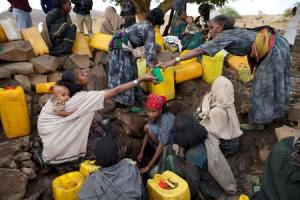By Katy Migiro
SERIEL, Ethiopia (Thomson Reuters Foundation) - The worst part of Mulugeta Kassaw's job is not when dangerously thin children arrive at his health center in drought-stricken northern Ethiopia, often at death's door.
It is when they recover and must be sent home.
"The mothers are not willing to go because they don't have anything at home to feed their children," said the public health officer whose clinic is in the Amhara region.
"It's heartbreaking ... We try to convince them by telling them there are other children who need treatment here."
Following two failed rains, the number of children Kassaw admitted for severe acute malnutrition with complications -- such as being unable to eat or suffering dehydration -- more than quadrupled to 25 in January compared with December.
Africa's second most populous nation of 95 million people is in the grip of its worst drought in 50 years.
The government and the United Nations have asked for $1.4 billion to feed 10.2 million Ethiopians -- the third largest appeal globally after Syria and Yemen.
Yet funding shortages mean food aid is in short supply and malnutrition will increase dramatically if donor money runs out in May, the U.N. World Food Programme (WFP) said.
At Kassaw's health center, mothers sit quietly on blanket-covered mattresses on floor, some cradling their babies, with a few plastic mugs and bowls arranged neatly by each bed.
Signs on the wall indicate if the babies are in phase one -- requiring antibiotics and milk formula fortified with protein, vitamins and minerals -- or had progressed to phase two, well enough to eat Plumpy'nut, a high-energy peanut-based paste.
Debre Mekuria came to the center five days ago, troubled by the weakened condition of her eight-month-old baby Tamin.
Despite the emergency food rations her family receives, and a loan taken out to buy maize, it was not enough. "I don't have enough to feed them well," the 30-year-old mother of four said.
MALNUTRITION FEARS
Funding and logistical problems present some of the biggest obstacles to dealing with Ethiopia's emergency.
The bulk of grain and cooking oil rations are provided by the Ethiopian government, which is also transporting water by truck and donkey to those in need.
WFP says unless there is additional funding, 7.6 million people will be deprived of food aid from May and moderately malnourished children will go without the supplements they need.
"We know it's a very precipitous decline into severe acute malnutrition in these areas once the food runs out and that's why we are so concerned," John Aylieff, WFP's Ethiopia country director, told the Thomson Reuters Foundation in an interview.
"If the food runs out in May and June ... it (malnutrition) is going to be off the scale."
Aylieff speaks from experience. A record 43,000 children were admitted with severe acute malnutrition in August because supplies of food aid failed to keep pace with escalating needs.
The government and agencies predicted in December that 2.2 million under-fives and pregnant and nursing mothers would become moderately acutely malnourished in 2016.
They also predicted that 435,000 children would become severely malnourished this year.
But these numbers could now rise dramatically because of funding shortages. And there are questions over how much capacity there is to respond in such a large country with poor infrastructure.
Food is imported through neighboring Djibouti, where ships usually wait several days for a berth. It is then driven thousands of kilometers (miles), often through winding mountain roads, to reach the people who need it.
"LAST RESORT"
Mothers and health workers in dusty villages nestled among the highlands of Amhara's Wag Himra zone told the Thomson Reuters Foundation that many families do not receive enough food aid to last until the next distribution.
"I have a family of four but I only get a ration for two," said Hana Mekonnen, 30, whose one-year-old son was diagnosed with moderate acute malnutrition in October.
She gives her baby fortified porridge, provided by aid agencies, three times a day. The rest of the family always eat injera, a sourdough flatbread that is Ethiopia's staple food, with red pepper instead of stew.
Health worker Firehiwot Zeru, who lives in the neighboring house, separated by a dry stone wall, said there is no milk because emaciated cows and goats have stopped producing, while villagers trade eggs for wheat because it fills more stomachs.
Increasing number of children are falling sick with malnutrition, diarrhea and eye infections, Firehiwot said.
Scabies, a contagious rash caused by mites that burrow into the skin, is also becoming common as people are unable to wash their bodies or clothes.
The Ethiopian government says it will find the money to feed its people if donors do not respond in time.
"It is the last resort if the situation becomes worse," said Mikitu Kassa, head of Ethiopia's National Disaster Prevention and Preparedness Committee.
It has already spent $380 million on the emergency response since July and has set aside another 6 billion birr ($283 million) for 2016, he said.
"We all hope like crazy that the Ethiopian government can fill the gap but that's a big worry," said John Graham, Save the Children's country director.
($1 = 21.2000 birr)
(Reporting by Katy Migiro; Editing by Katie Nguyen; Please credit the Thomson Reuters Foundation, the charitable arm of Thomson Reuters, that covers humanitarian news, women's rights, property rights, human trafficking and climate change. Visit http://news.trust.org to see more stories)
